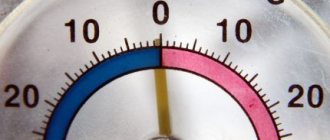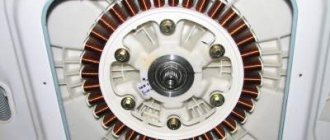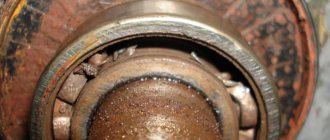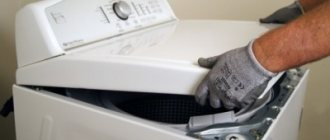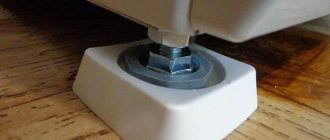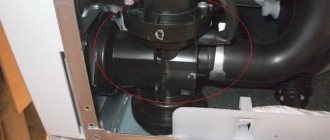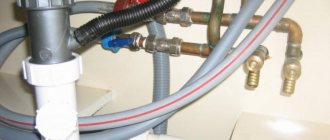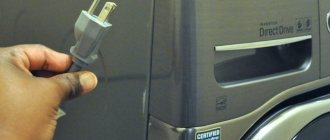Sales of washing machines in villages are growing steadily. However, connecting them can be a real headache, since central water supply in rural areas is practically unnoticed.
How to make a washing machine work flawlessly in “special” conditions: this pressing problem is the subject of a publication from the heading “People’s Expert: Your Own Master.”
Author: Andrey KASHKAROV, St. Petersburg.
Andrey Kashkarov as an innovator
Innovator as Andrey Kashkarov
About existing connection options
The main condition for any option is the organization of water supply under certain pressure indicators. There are several solutions to get the result:
- Adding water manually. Water is added through the detergent compartment added to the machine. But there is also a significant drawback - the device stops every time the program ends. To continue working, you need to add water. This process can be quite labor intensive and time consuming.
- Installation of pumping stations to which you can connect a washing machine in the country. Such decisions are associated with additional financial costs. And such expenses are not always justified, especially if the dacha is used only in the summer, and only the washing machine requires connection. A source of clean water is important, but such amenities are not always available.
- Creating pressure artificially. The result can be achieved by placing the water tank significantly higher compared to the washing machine. An 8-10 meter indicator is considered optimal. You can completely cope with the work if you have two floors and an attic. But the downside is that water is always delivered to the second floor.
Imitation of a pumping station. A pump with small dimensions is installed between the water tank and the washing machine. The method does not require financial investments, which is why many consider it the best way to connect an automatic washing machine in the absence of running water in the village.
Container for detergents (manual method)
It is assumed that during this type of work water is poured in and drained out manually. Sometimes the choice is made in favor of semi-automatic machines. Placement will not cause much trouble due to the small dimensions of the equipment. Low price and high maintainability compensate for the lack of access to some other useful functions when connecting a washing machine without running water using a container or other methods.
With the manual washing method, the most serious drawback is the large amount of manual labor. The quality of the result often depends on the heating, and it is not always possible to raise the temperature high enough. To remove foam, a large amount of water is used for rinsing.
Container with water
To create additional pressure in the system, you can select liquid reservoirs. The best option is if the house has a second floor. The downside is the need to carry water to refill the tank. If you have a large house, work may become problematic.
Let us assume that such tanks are manufactured independently. To create the required pressure, the device is placed under the machine. You can purchase any equipment; you don’t have to choose a specific manufacturer, including in the countryside.
Well drilling
It’s good if there is already a well on the site. Then you only need to install a powerful pumping station to organize uninterrupted operation. Otherwise, you will have to call a team of specialists to organize drilling. But it is necessary to take into account several factors with which such work is associated:
- team work and equipment rental require additional costs;
- the best time for drilling is summer;
- It is recommended to use only good quality water. Otherwise, there is a high probability that in some cases the clothes will not be washed at all. But a well will be a great way to save money.
How to choose?
It is quite difficult for an ordinary consumer to understand the water pumps offered. You shouldn’t completely trust sellers and consultants; they can sell you on an expensive pumping station that you don’t need. How to buy suitable equipment:
- Select equipment for specific conditions.
- Give preference to well-known manufacturers. Cheap pumps may break down after a month or two.
- Be interested in the noise level, otherwise over time you may encounter inconvenience from a loud device.
Classification of pumps by control method:
- Manual. Manual on/off.
- Automatic. Triggered based on sensor readings.
Washing machine operating options
There are a lot of ways to connect an automatic washing machine without running water; let’s look at the most popular ones.
Handmade
We do not mean hand washing, but pouring water by hand. This process is painstaking and time-consuming. You have to stay near the machine throughout the entire washing cycle. When the washing stage comes, at which water is needed, the machine will stop and water will have to be poured into it manually from a bucket or through a hose. Topping up occurs through the washing powder compartment. Due to the fact that the washer will constantly stop the wash cycle, it will break down faster.
Container for water
This method, how a washing machine can work without being connected to a water supply, is the most convenient, but it requires certain resources for its implementation. The tank, which should be located above the level of the washing machine, will create pressure, and the water will flow into the device by gravity.
You will have to fill the container manually and control the water supply in it for the next wash. One load will require from 100 to 200 liters of water. This convenient method has its drawbacks, including:
- Constantly loading water into the tank will be a problem; if you carry 10-15 liters in buckets, then you will have to do a lot even for 1 wash.
- Raising such a large tank to a height and securing it is also not easy.
Another option with a water tank is to install a small pump between it and the machine. In this case, there is no need to lift the container; it can be installed directly next to the washing machine. Before connecting a washing machine without running water using this method, you should buy the same pump. It will cost 500-800 rubles, the power that will be enough is 40 W.
You need to make a hole in the tank for the adapter, to which the pump is connected, and carefully seal it to prevent leakage. The pump outlet must be connected to a hose that is connected to the washing machine. This entire structure is powered through a solenoid valve coil.
Connection diagram for an automatic washing machine without running water
Well
If the dacha is planned as a place to live in the warm season, then it makes sense to drill a well. This will provide an individual source from which you can get water, including for drinking and toilet maintenance - that is, completely replacing the centralized water supply. In this case, connecting the washing machine will not be difficult; all manipulations are carried out in the same way as if it were installed in an apartment.
It will not be possible to drill a well in winter; you will have to wait for the warm season when the ground thaws. The cost of such work is considerable; if you come to the dacha only from time to time, then such investments are impractical. It is better to choose one of the methods presented above.
Connecting a washing machine without running water
Using Well Water
An option for connecting a washing machine is to run pipes from the well; in this case, you also need a pump of sufficient power. It is worth understanding that it will not be possible to implement this method if the distance to the well is more than 10-15 meters, the pump simply will not be able to pump over such a distance.
When using this method, it is necessary to install a filter (magnetic or mechanical) in front of the water intake hose; it will not allow sand, branches, leaves and other objects that are always present in well water to reach your clothes. If this protective measure is not applied, the washing machine will quickly fail.
How does an automatic machine work?
The operation scheme is extremely simple if there is access to a sewer drain and a source for water intake and power supply. The process includes the following steps:
- The water is directed into the washing powder compartment, then through a rubber tube it is sent to the drum, where there is dirty laundry.
- After the cycle is completed, the water is drained through the hose.
- An electromagnetic valve is responsible for supplying water to the device; the liquid is supplied under high pressure. If the pressure is weak, the pump will fail.
Types of activator washing machines and market analysis
There are different models of activator washing machines. They differ in their functionality and price.
The units differ in capacity, that is, the maximum weight of dry laundry that can be washed in one load. The most compact models hold no more than 2 kg of things. One double set of satin bed linen weighs approximately this much. The largest machines can hold up to 6 kg of laundry.
Depending on the complexity of the washing programs, the following types of machines are distinguished:
- Simple ones that can only mix laundry in a tank of water, and are controlled using a toggle switch that has 2 positions - “on” and “off”.
- With washing program selection function. As a rule, such units provide normal and delicate modes.
- An activator-type washing machine can be equipped with a laundry spin function. It contains a drum, which, rotating at high speed, presses the laundry against the walls, and thereby dries it. Unlike automatic washing machines, clothes must be transferred manually into such a tank after washing.
Boris Vitalievich master
Like any other equipment powered by electricity, washing machines are divided into energy consumption classes A, B, C, D, E, where A is the most economical, and E is the most energy-intensive class
When choosing, you should pay attention to these letters, since during operation, the savings when purchasing the model you like can be completely covered by unreasonably high electricity costs.
Renova – WS series
The Russian brand Renova produces a whole line of semi-automatic washing machines. The WS series is characterized by the presence of several washing modes (normal, delicate and drain), good spin performance, and a maximum load of up to 6 kg of laundry.
Consumers note the good value for money of the product. The disadvantages include the high level of electricity consumption (class D). Approximate price – 8000 rubles.
I like5 I don't like5
Fairy – SMP series
Two-chamber semi-automatic washing machine. Its size does not allow it to be called compact, but the manufacturer has placed 2 compartments under the body - for washing and for spinning.
The load is average - 3-4 kilograms of dry laundry, which is an excellent option for one person, but not enough for a family with children. The Fairy machine has intuitive controls. The price is quite affordable - approximately 7,000 rubles.
I like8I don't like1
Snow White – HRV series
Activator washing machine with vertical loading of laundry. The line includes models with and without spinning. The maximum load volume of laundry is small – up to 3 kg. But the energy consumption class is the most economical.
The manufacturer limits the temperature of the water that can be poured into the tank to 50 degrees, which is a disadvantage when washing children's clothes or heavily soiled laundry. The average price is 5000 rubles.
I like7I don't like2
Evgo – WS series
A distinctive feature of this series is the presence of reverse in the design of the activator, which significantly improves the quality of washing and prevents laundry from tangling. The model is supplemented with a timer with a maximum time of 15 minutes.
Energy consumption class A. Price in retail chains – from 6 to 7 thousand rubles.
I like8I don't like2
Slavda – WS series
A modern line of Polish activator washing machines, characterized by a very large tank with compact body dimensions.
The maximum load of laundry is 8.5 kg, which is a very good indicator even for automatic machines. Moreover, its price is more than affordable, on average 4,000 rubles.
I like8I don't like2
Leran TWM
Another Russian manufacturer of household appliances, including inexpensive semi-automatic washing machines. Consumers note good quality at a low price.
Leran models have simple controls and compact sizes, complemented by a convenient carrying handle, which makes them a good choice for the garden. The average cost in the Russian Federation is 3,500 rubles.
I like12I don't like1
Gorenje WP7Y2/RW
Innovative development of an Italian brand of household appliances. In essence, this is an automatic washing machine with a drum, but it draws water into the drum not from the central water supply, but from the water tank attached to it, which allows it to be used where there is no centralized water supply.
Its price is significantly higher than any activator machines and many automatic washing machines. On average, it can be purchased for 27,000 rubles.
I like8I don't like1
Circulation pump
This is a more complex design that ensures fluid circulation in the system. This format can significantly reduce water consumption. The main task of the circulation pump is to drive water only in one direction, that is, along a closed path. Such devices can work in tandem with a conventional drain pump, which significantly increases the efficiency of the entire structure.
Circulation pumps are equipped with equipment in the premium segment, less often in the mid-budget segment. Moreover, every well-known manufacturer tries to improve the device, introducing something new and useful. Thus, the Samsung brand included a seal in the design of the pump, which prevents water from escaping beyond the main circuit. Thanks to this solution, the bearings always remain dry, and this significantly increases the service life of the product. The company also uses a proprietary lubricant that eliminates most of the problems associated with rubbing mechanisms. As a result, the pump operates trouble-free for many years, while maintaining stable performance. Other brands have similar solutions.
Pump for Samsung washing machine
Standard connection cars automatic
Selecting a location
So, you have become the owner of a brand new automatic washing machine. Now all that remains is to connect it with your own hands to the water supply and sewerage system. But, before you do this, you must first find a suitable place for it.
In standard city apartments there are not so many options, so in most cases washing machines are placed in the following rooms:
- In the kitchen;
- In the toilet;
- In the bathroom or combined toilet.
When choosing a place to go, be guided by the following rules:
- You need to ensure a free approach to the installed device.
- The device should not interfere with movement.
- It should be possible to connect the water supply to the machine and connect the drain.
Once the location has been clarified, it is possible to begin the upcoming actions.
Unboxing
Manufacturers pack complex household appliances, such as washing machines, very carefully so that they are not damaged during transportation. Based on this, before installing the device, it is necessary to free it from the original packaging and remove the bolts that secure the drum.
In addition, you need to remove the plugs, which are used to protect the holes from liquid getting into them. Keep the bolts as they may be needed in case of equipment transportation.
The procedure for removing all transport elements is contained in the instructions, which are necessarily attached to each product. If you carefully follow the diagram, you will be able to unpack and connect the equipment without any trouble.
Connection to water supply
Most washing car models can only be operated if an uninterrupted water supply is ensured. To do this, the device is connected to the water supply using an inlet hose, which is supplied with the machine.
There is a special hole on the back of the machine to connect the hose to the machine.
Its other end must be connected to the water supply as follows:
If the system does not provide a special outlet, you need to buy a ball valve with two outlets or a pipe tee and a simple ball valve.
- After this, you need to turn off the water in the system and install the tap in a suitable place. This procedure depends on the material from which the water supply is made. If, for example, the pipes are made of polypropylene, a special soldering iron will be required to install the fitting.
- After inserting the tap, you need to connect the hose to it by screwing the union nut onto the thread.
In fact, this completes the procedure for connecting to the water supply.
Connection to sewerage
There are two methods to connect the washing machine to the sewer:
| Through plumbing fixtures | For this purpose, the drain hose has a special hook that allows you to attach it to the edge of the bathtub, sink or even toilet. This method is the simplest, but not very ergonomic. |
| Stationary | To do this, purchase a special siphon with two inputs, which is connected to the nearest sink or washbasin. One input of this device is designed specifically for the machine. |
In most cases, owners of washing cars prefer the second method, but it is temporarily possible to remove the drain through the nearest plumbing fixture.
Vending machine without running water
An automatic washing machine makes life so much easier; you can forget about washbasins and washed-out hands – in a couple of hours your clothes are clean, you just need to dry them. It is not surprising that such a household appliance is also installed in the country. But the key problem of every country house is the lack of water supply and sewerage; if the second problem is easier to solve, then with the first you will have to resort to various tricks. Which solution you choose is up to you.
The main advantages when using an automatic washing machine are as follows:
- You can use rainwater for washing; it is softer than that in wells and wells. It perfectly washes even the most difficult stains.
- If there is a well or well on the site, then you do not need to pay for water; all you have to spend on washing is powder and a little electricity.
- You can send an old washing machine from a city apartment to the dacha. It will last for more than one year.
Note! There is no point in buying an automatic washing machine specifically for your dacha; you can buy a cheap option with manual control. For example, Slavda is suitable, which costs from 3 thousand rubles.
Connection options
As mentioned earlier, we will consistently talk about the most common ways in which an automatic washing machine without running water will definitely work. And we’ll tell you about the method that, in our opinion, is optimal. We will let you choose which one is better.
How can you set up the system?
- The easiest way out is to pour water directly into the powder bin with your own hands. At the same time, a washing machine can do without running water, especially its mechanical version. By and large, the technology doesn’t care where the water is poured from, as long as the tank is filled and the level sensor works.
- The problem is that after each cycle the unit will turn off and wait for you to come running with a bucket and pour water into it through a watering can. And running with a bucket is not the easiest thing, it turns out to be semi-automatic.
Standard filling hose.
You can resort to a similar, but slightly improved method. Remember the principle of communicating vessels and place the tank on a hill. But in order to create pressure sufficient for the automation to operate, the tank will need to be raised to a height of about 10 m. And again, carry water there with your own hands.
Machine diagram.
- All questions like how to connect a washing machine if there is no running water disappear if you have a pumping station. Even the simplest unit with low power is quite capable of providing the pressure necessary for the operation of the machine. Everything is good here, except for one thing: the price of a simple pumping station starts from 5,000 rubles, plus filters and fittings for it.
- If a washing machine in a village without running water is connected through the station, then it makes sense to buy a pumping station. In summer it will be useful for irrigation, and in winter it will supply drinking water to the house. For seasonal use, the option is quite expensive.
- But there is, in our opinion, the best and at the same time low-budget option. Its meaning is to install an additional pump, which will simulate the operation of a pumping station and automatically fill the tank with water. Instructions for self-assembly will be covered in the next chapter.
Pumping station.
Intermediate pump installation
Before installing an automatic washing machine without running water, you will need to take care of two main things. The first thing you need is a water container. According to experienced summer residents, the best option would be to place a standard two-hundred-liter barrel next to the machine. Of course, economical units can get by with 100 liters, but there won’t be any extra reserve here.
The second device you can’t do without is a small water pump. If you are not a great expert in this equipment, we advise you to go to a store that sells spare parts for automatic machines and purchase a pump. It is better to take a pump from the manufacturer whose machine you have.
Powder hopper.
Next, in order not to overload the pump, we recommend installing a ball valve into the bottom of the barrel. It is to this that the intake hole of the unit will be connected. The pipe from which water will be pumped under pressure is connected to the inlet hose.
Submersible aquarium pump option.
Next comes the most important part. We need to connect the pump to the network and at the same time make it so that it turns on when necessary
If you remember, at the beginning of the story we mentioned that any machine has a solenoid valve that opens when the tank is filled.
This valve operates from a 220V network and is in the open position only when operating voltage is applied to it. This is an ideal option for us. It is necessary to remove the top cover of the machine and connect the pump in parallel to the solenoid valve.
Parallel connection of valve terminals.
This can be done directly at the valve terminals or trace where the wire goes, as a rule, it is in the lower part of the housing and parallel the valve and pump on the terminal block.
As a result, we will have a washing machine that does not require a connection to the water supply. At the moment when you need to fill the tank, the automation gives the command to apply voltage to open the valve. But we connected a pump to it in parallel, as a result they turn on simultaneously and water flows into the tank. When the tank is full, the system turns off both units. (See also the article Pumps for water supply from a well: features.)
The video in this article shows a similar installation option for an intermediate pump.
Ensuring the required water pressure
Pumping station
To maintain the required pressure, you can install a pumping station. Its function is to ensure constant water pressure. The pumping station solves absolutely all possible issues with any types of washing machines. Its installation is no different from the city one.
But such a system simply cannot be cheap. The average price of such a design is 5–6 thousand rubles. The station also requires a constant and uninterrupted supply of clean water.
A similar system is used in capital country houses.
Simulation of a pumping station
The most rational, practical and affordable way is to imitate a pumping station. This method allows you to use rainwater in your laundry. You will need any pump (it can be submersible, drainage, centrifugal), a simple hose, and a pressure switch.
Next, the circuit is assembled: the machine is connected to the hose and to the pressure switch using a tee. One wire from the relay goes to the network, the second to the pump. Before starting work, you need to make sure that the relay is set to minimum pressure.
Operating principle: if there is no pressure in the hose, the relay closes, and the pump produces this pressure. After opening the valves of the machine, the level drops sharply, the relay turns on, the pump starts pumping, and the washing machine fills up. When the filling is completed, the valves close, the pressure rises, and the relay stops the pump.
- The connection between the tee and the hose can be made quick-release, this will reduce the time spent.
- This design will allow the owner to use both the hose and the pump for their intended purpose, and when the need arises to wash, assemble the device again.
- The tee and other small parts are hidden behind the machine using self-tapping screws on metal surfaces.
Connecting a washing machine in the absence of water supply is not as difficult as it might seem at first glance.
Depending on how much money you are willing to spend on this, and how often you plan to use the equipment, you choose one of the methods of installing the washing machine.
Living in a country house has many advantages. Clean air, products without harmful additives, absence of city noise - many residents of megacities purposefully purchase suburban housing in order to be able to plunge into such an atmosphere at least for a while. However, when making such a choice, you need to be prepared for “special” conditions, since most villages in our country are deprived of many of the benefits of civilization. This makes it difficult to operate some household appliances, in particular a washing machine. And if there should be no problems with electrification, then the presence of a central water supply is a real luxury. Nevertheless, you can find the optimal way out of every situation. And even in such conditions it is quite possible to use automatic washing. You just need to know how to connect a washing machine without running water.
In modern machines, the washing process is completely automated. All a person needs to do is add detergent to a special compartment and select the required mode. All work is controlled by an electronic controller, which collects water, selects the rotation speed of the drum and promptly turns on the pump. In addition to the operating cycle, the electronics monitor the correct operating conditions and interrupt operation if any malfunction occurs.
Electronics not only controls the washing, but also monitors the correctness of the process.
It is quite natural that no washing machine will work without water. Therefore, in the absence of a central water supply, you should think about alternative ways to organize water intake. At the same time, to achieve the desired result, it is necessary to understand how the collection and movement of water occurs during washing.
Upon command from the controller, water flows through the fill valve into the compartment with detergent, after which it fills the tank. Filling control is carried out using a level sensor, which transmits a signal to the controller to close the inlet valve. After washing, the pump is turned on to remove water from the tank. Depending on the selected program, the pumping/draining process can be repeated several times during one wash cycle.
Movement of water in a car
Methods for connecting a washing unit without running water
Filling with water through the detergent container
Experienced craftsmen know one famous tricky way. It consists of filling the detergent container with water. It is easy to use and does not require complicated steps. But its disadvantage is that it is necessary to restart the washing mode constantly.
That is, a person must open the container, place the powder in it, then put the laundry into the drum. After this, the wash starts, water is added, and the machine is stopped. Then the washing begins again, at the end the water is drained and the process is stopped.
Despite its simplicity, this method is irrational. It is time-consuming and does not always guarantee reliable results. In addition, not every machine is capable of working at such a rhythm on a regular basis. Therefore, it is worth considering other methods.
Using a water container
To avoid using the previous method, it is worth considering the simplest water supply method. This can be called installing a tank with a container above the washing machine. It looks interesting and seems to solve the problem for a long time.
But there is a certain nuance here too. This is not very easy to do in practice. After all, this requires a container with a volume of 10 liters or more. It is then that the necessary pressure of 1 bar will be provided to raise the water into the washing machine.
Using a well
Many homeowners, not having the money to drill a well, prefer to use wells. They are built from polymer pipes or reinforced concrete rings. Water is extracted using pumps or gates.
The question immediately arises of how to ensure an uninterrupted supply of water. Without this, it will be almost impossible to carry out the washing process. You can use the following popular methods:
- Construction of a water tower with equipment. This includes a centrifugal pump and a heating system. This will allow you to receive water even during frosts.
- You can ensure an uninterrupted supply of water through a large tank. To do this, install an automatic pump, which is activated when there is pressure in the system.
- And finally, manually pouring water into the container. But this method is very unreliable and requires constant presence when washing. A plus is the absence of the need for spinning and other manipulations.
However, well water is not suitable for home use. It contains mineral and chemical impurities, and there is also a possibility of fecal contamination
Therefore, it is important to use special filtration systems that can remove any impurities and dirt. Otherwise, there is a possibility that the operation of the washing machine and all equipment in the house will completely deteriorate.
Well drilling
This method is suitable for wealthy owners. The natural well is equipped with a pumping station operating in automatic mode. Then the procedure for installing a washing machine will not differ from a similar process in a city apartment.
The disadvantages of this solution are the high cost and composition of the water. The aquifer can lie very deep. Then drilling and further connecting to the well all the elements necessary for this can cost a significant amount. In addition, the water from the well contains many mineral salts and mechanical impurities, which will quickly damage the equipment. The problem is solved by installing powerful filters.
Using a washing machine with a built-in tank
Often in homes there is no opportunity to install a separate container. Then the solution would be a washing machine with a tank. Initially it was intended for a mobile type of household, then they were adapted for stationary houses. Despite the increased cost, they have proven themselves well.
The design of such devices includes a tank, which also contains a pumping component in the form of a relay, pump and sensors. Therefore, no locking elements or containers are required here. They differ from conventional washing machines only in size. Moreover, their functionality is almost identical.
Useful tips
When installing a pump for an automatic machine that increases the inlet pressure, follow the installation rules that will extend the service life of the equipment:
- Place a mechanical filter at the inlet - it will trap dirt and rust particles. If solid particles get into the washing machine water pump, they will cause it to break down.
- To prevent vibration of the pumping equipment, check the quality of the fasteners in time, and if necessary, tighten them.
In what cases is it necessary to connect a machine without running water?
Modern equipment allows even in the country to create normal conditions for the high-quality operation of any automatic washing machine. To do this, we need to remember the principle of operation of such devices.
How does a washing machine work?
An automatic washing machine (AWA) is an intelligent household appliance that can perform its duties with just three connections:
- to an AC electrical network with a voltage of 220 volts;
- to a source of clean water supplied with sufficient pressure to dissolve detergents and fill the tank with pressure;
- to the place where waste solutions are drained.
Scheme of operation of the washing machine
All actions of the machine are controlled by a control unit that gives commands to the motor that rotates the drum, the pump that pumps out the liquid, the valves and sensors that regulate the process of filling the tank with liquid. After loading the laundry and pouring the powder into a special bath, the valve on the water supply line opens. She washes off the powder and fills the tank to a certain level. The heating element is responsible for heating it.
The processes of soaking, washing and spinning occur when the drum rotates at the required speed. During operation, water is pumped out of the machine several times, taking with it all foreign matter. As a result, the housewife takes out slightly damp, clean linen, which only needs to be dried and ironed.
For information! Some models are capable of dispensing items in a dried state without creasing.
It turns out that there are almost no problems with these connections in rural areas. Electrification is everywhere. During power surges, you can use a gasoline or diesel power generator. To drain dirty solutions, there are septic tanks or cesspools, and to supply water there are a lot of technical devices that create the necessary pressure. You just need to know how to connect your washing machine without running water.
Benefits of using SMA without running water
The operation of automatic washing machines in villages that do not have a centralized water supply can provide their owners with tangible benefits:
- You can use rainwater, which is considered the softest and purest. It allows you to wash things efficiently using a minimum of detergents. At the same time, scale does not form on the heating element, which extends its service life.
- There is no need to pay for using water from your own well or borehole, and this is a direct saving on the family budget.
- The old model, which you considered unsuitable for a city apartment, can serve in the country for many years.
If you value convenience, then you can safely bring new or used equipment to your country house, knowing exactly how to connect a modern automatic washing machine without running water.
What do you need for laundry at the dacha?
Water and electricity. If the issue with electricity has been resolved long ago and everywhere, then with water it is much more complicated. Well, you can wash without a sewer drain - drainage in the private sector can always be organized without special costs. Connecting a washing machine to a country house without running water is possible, the main thing is that there is electricity and a source of water, everything else can be solved. Water supply sources:
- Precipitation. Collect rainwater. It is better than in a well - soft, no need to add softeners. Things wash well.
- Well. Free source.
- Well. You will have to spend money to drill it.
Let's find out how an automatic washing machine (AWA) is connected to a water source - what water supply options are available.
Checking the contents and documents
Take the instructions, which will indicate all the components for the machine. These include hoses, plugs, warranty document and operating instructions
It is very important that the availability fully matches the records
Documentation must be verified. Instructions for use must be detailed, in Russian. The warranty card checks the date of completion and year. The serial number of the washing device and model are also indicated here. Any violation in the execution of this document will be a prerequisite for refusal to service the machine.
If there are no problems with the documents, you can carry out further inspection.
Installation of contact pumping device
This is the most popular method, so let's start with it. If you purchase a pressure pump, then purchasing this small-sized product will not be burdensome for the family budget. The circuit is elementary, consists of three items: a pump, a hose from the machine itself, and a container of water.
Using an External Pressure Pump
The first thing you need to do is purchase the following items at the hardware store:
- Adapters;
- Two two-core cables;
- Silicone sealant (for fixing adapters).
Then it is important to adhere to the following scheme:
Use a drill to make a hole in a tank of water.
It is used for installing adapters. The attachment points of the adapters are treated with sealant; it is important to let it dry for 24 hours. The ends on the pump tubes (used for connecting adapters) must be cleaned with sandpaper. The adapters themselves need to be lubricated with sealant and screwed onto the tubes. You need to solder a wire to the pump contacts. It is important to protect it with heat shrink tubing. After the sealant has dried (preferably after a day), you can connect the pump to the washing machine.
After filling the tank with water, you can start washing. We insert the pump into the container. It is plugged into a regular outlet as needed, as soon as the washing machine needs water.
Pump application
It is also possible to install a system consisting of an electric pressure pump and a water tank (for example, a barrel). This method is optimal in terms of cost and efficiency.
The pump will move liquid under pressure from the reservoir into the apparatus compartment. But without automation, you need to turn the pump on and off manually, while simultaneously monitoring the water level in the machine.
Pump application
Required spare parts for manufacturing the system:
- Pumping device.
- A barrel or other container for liquid.
- Set of gaskets and clamps.
- Set of flow filters.
- Silicone based sealant.
- A couple of meters of hose for the pipeline.
- A tee valve for shutting off the flow of water from the tank.
- Tools for measurements and installation.
- To automate the washing process, you will also need either an electromagnetic relay or reed switches.
Expert opinion
I work in the household appliance repair industry. Extensive experience in restoring washing machines and dishwashers.
Ask a Question
For greater compatibility, it is advisable to buy a pump of the same brand as the washing machine itself. A lid is also required to protect against accidental splashes.
Let's consider assembling the pumping system and connecting it to the washing machine:
- Let's choose a place to install the device. A flat, concrete surface if possible is required; the socket must be within reach of the wire.
- Place a container of the required volume nearby, preferably with a lid for convenience.
Do you wash your shoes in the machine?Oh yes! No
- To improve performance, you can make a stand for a barrel, about a meter high.
- Make a hole of the required diameter on the bottom wall of the tank for a tee tap and fix it.
- Connect the pressure hose to the tap, and connect the other end to the pump.
- Using an adapter, attach the discharge hose to the inlet hose of the washing machine.
Now you need to remove the top cover of the machine and find the solenoid valve. Let's remove the seals from it to improve water flow and install a flow filter in front of it. All that remains is to test the operation of the system.
Electrical connection
You can connect to the power supply through an outlet. The closer it is to the washing machine, the better. Modern technology requires a grounded European socket.
It is better to choose a special socket with a lid that protects from moisture. It is worth noting: if you want to install the machine under the sink, then you need to choose a sink in which the siphon is located not in the center, but at the back. If the house is old, check that its power matches the power of the machine indicated in the instructions (2000 watts or more). If it does not correspond, you can lay a wire in the wall to the meter and install a separate 16 Ampere circuit breaker.
This wire should consist of three cores. Connecting a washing machine through an extension cord is very undesirable. The instructions for some models specifically prohibit this.
Expert advice: to avoid electric shock, you can lay a rubber mat under and next to the machine, at the same time it will reduce vibration during the spin cycle.
Leg adjustment and testing
After the washing machine is connected to electricity, it needs to be leveled. A prerequisite is the need to bring the upper part of the machine to a strictly horizontal position. Only in this way will the drum be positioned correctly, without distortion, which will ensure its smooth rotation and prevent harmful shaking and loosening.
The maximum permissible horizontal deviation is only two degrees. For the required horizontal position, the legs are adjusted (most models have this function). Monitor the result using a building level until it meets the requirements.
After checking all the connections and connections, checking the instructions, do a test run, doing all the necessary operations, checking for correct operation:
- Set of water. If it does not stop, it means that the drain hose is not connected correctly and water is going down the drain.
- There should be no extraneous sounds when the drum rotates; they usually occur during incomplete removal of the transport fasteners.
- Heat. The heating time of the collected water is usually 5-15 minutes (depending on which washing mode is selected).
- When connecting to hot and cold water, monitor the dial in different modes. It is likely that one connection is not made correctly.
- Wait for the drain to turn on. If the water drains slowly or if the water does not drain at all, it means that the pressure switch (water sensor) is probably broken.
- Check for the presence/absence of leaks, both in the machine itself and in the drainage and water intake areas.
All other parameters depend on the specific washing mode. Therefore, before turning on, be sure to read the operating instructions. This completes the testing of the washing machine connections.
Now you know how to connect the washing machine yourself to all networks: water supply, sewerage, electricity. The main thing is to follow the sequence and reliably connect all the nodes. Do not forget about the most important factor for the correct operation of the device - installation on a flat base and connection to a grounded outlet, because the price of new equipment is considerable.
Additional tips can be seen in the video:
What pressure does the pump create?
There are different models of pumping equipment on the market. Let's look at the most popular options. The proposed equipment increases the pressure to 3.5–6 bar. All models have overheating protection.
Wilo PB-088EA. Costs 3,800 rubles. 3.5 bar. Temperature - 2–60 °C. Installation - horizontal or vertical. Throughput - 2.4 cubic meters/hour.
Grundfos UPA 15-90. Price - 5,500 rubles. Passes 1.5 cubic meters/hour. Installation - vertical. For clean water only. 6 bar. Noise - 35 dB.
Gilex Jumbo 60/35 P-24. Price - 5,400 rubles. 3.6 cubic meters/hour.
Marina Cam 80/22. Surface pumping station. Costs about 9,000 rubles.
The maximum pressure in the above models is 9.8, 35 and 32 m, respectively.
Benefits of Friendly Service
- Our team employs only professionals, highly qualified specialists who have proven their knowledge and skills in practice. The craftsmen have extensive experience in working with Gorenje brand models.
- We do not use cheap analogues in our work, because we are confident that the result of the repair largely depends on the quality of the components.
- We accept urgent requests for washing machine repairs. The master arrives at the client’s home or dacha on the day of the request or at any time convenient for the customer.
- The quality of servicing household appliances at home or in the country is no worse than repairing appliances in a workshop. Our technicians have professional equipment for diagnosing and restoring washing machines.
Prices for our services remain attractive for users of universal household appliances. We also advise customers on the operation and maintenance of water tank washing machines over the phone.
Choosing a location for installation
Installing the machine under the sink saves space
Before buying an automatic machine, you need to think about where to place it. Although if the device does not need to be built in, you can think about the location after purchase. It is necessary to measure the free space and determine the dimensions of the device that will fit there. A vertical loading unit occupies a smaller area. First of all, the choice of a corner for it is determined by the layout of a private house, apartment, cottage and the area of the premises. Basically, the unit is installed in the bathroom. This is convenient, especially in terms of having the necessary communications. But there are apartments where the bathroom only has space for a bathtub and sink. In this case, the machine must be installed in the kitchen.
It also allows you to connect equipment to:
- water supply;
- sewerage;
- electricity.
If possible, it is placed in a utility room. To do this, use an adapter in the form of a PVC pipe. When there is also drying equipment, they are mounted on top of each other in a column to save space.
